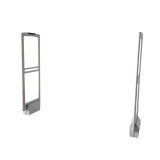In the retail industry, hard clothing EAS security tags play a crucial role in preventing theft and protecting merchandise. As shoplifting becomes an increasingly prevalent issue for retailers, implementing effective security measures is essential for safeguarding inventory and ensuring profit margins. This article explores the benefits, types, and best practices associated with hard clothing EAS security tags.
Understanding EAS Security Tags
Electronic Article Surveillance (EAS) systems utilize security tags to deter theft and protect merchandise. Hard clothing EAS security tags, typically made of durable plastic, are designed to be securely attached to clothing items. These tags are equipped with electronic sensors that trigger alarms at store exits if an attempt is made to remove them without proper deactivation.

Benefits of Hard Clothing EAS Security Tags
- Theft Deterrence: The presence of hard clothing EAS security tags serves as a strong visual deterrent against shoplifting. Potential thieves are less likely to steal items that are tagged.
- Inventory Protection: By effectively reducing shrinkage, retailers can maintain better control over their inventory. This ensures that customers can find the products they want without frequent out-of-stock occurrences.
- Cost-Effectiveness: While there is an initial investment in EAS systems and tags, the reduction in theft and increased security often outweigh the costs. Retailers can save significant amounts that would otherwise be lost to shoplifting.
- Customer Safety: An enhanced security environment not only protects merchandise but also creates a safer shopping atmosphere for customers. When shoppers feel secure, they are more likely to spend time in the store.
Types of Hard Clothing EAS Security Tags
There are several types of hard clothing EAS security tags available, each tailored to meet specific retail needs. Pin tags are the most common, easily attached to clothing with a pin and removed by staff using a detacher. They provide a reliable security solution for a wide range of apparel. Additionally, some retailers choose custom-designed tags that incorporate their branding, adding an element of aesthetic appeal to the product while maintaining security. These custom tags not only deter theft but also enhance the visual presentation of items, making them a versatile option for retail environments.
Best Practices for Implementing Hard Clothing EAS Security Tags
- Strategic Placement: Ensure that hard clothing EAS security tags are attached to high-risk items and in areas most susceptible to theft, such as near store exits and fitting rooms.
- Employee Training: Staff should be trained not only in the proper use of EAS systems but also in how to recognize suspicious behavior and manage potential theft situations calmly and effectively.
- Regular Maintenance: Continuous maintenance and testing of EAS systems ensure they are functioning correctly. Regular checks help identify issues before they impact security.
- Integration with Other Security Measures: Combine hard clothing EAS security tags with additional security measures, such as surveillance cameras and security personnel, to create a comprehensive theft prevention strategy.
Conclusion
Hard clothing EAS security tags are an indispensable component of any retail theft prevention strategy. By understanding their benefits, exploring the various types available, and following best practices for implementation, retailers can significantly reduce theft, protect their inventory, and enhance the overall shopping experience. Emphasizing security not only preserves products but also builds customer trust, ultimately contributing to long-term business success.


































